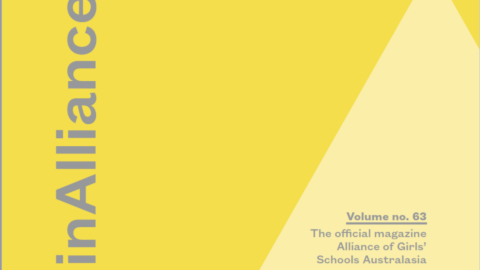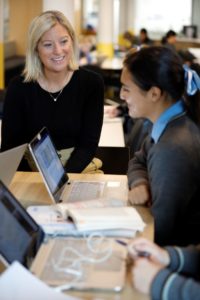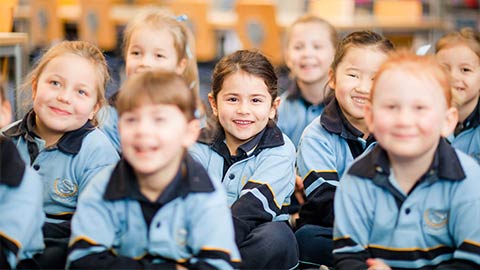COVID Transforms Learning at St Catherine’s School

Head of English and Project Leader of St Catherine’s School’s, Senior Years Learning Model, Mrs Ceri Lloyd, explores how COVID transformed learning at St Catherine’s, in her research article, published in the Alliance of Girls’ School’s Australia Journal, October 2021.
Disrupting the norms to transform learning: Learnings from 2020
“Real change takes place in deep crisis, you will not stop the momentum that will build.”
— Andreas Schleicher, Director for Education and Skills, Special Advisor on Education Policy to the Secretary-General at the Organisation for Economic Co-operation and Development, 2020.
The “deep crisis” came in the form of COVID-19, a pandemic that none of us could have predicted, which created the catalyst for significant educational change and reform. Educators recognised the necessity to shift their educational delivery and pivot quickly into a remote learning environment. At St Catherine’s School, we have always been committed to adapting our model of learning and educational platform in a way that meets the needs of our students in a rapidly changing world. Teaching methodology needs to evolve to keep up with changing times and incorporate integrated technologies into learning in a relevant and accessible manner. Our role as educators is to equip, enable, and empower students with the learning and competencies they will need not only during their secondary schooling, but post school (Cummins, 2020). However, nothing we learnt could have prepared us for the 2020 year in education.
During St Catherine’s School 2020 Learn@Home program, it became clear that we needed to harness and expand upon the remote learning environment that we had been thrust into. If we didn’t take up this challenge, then we would be missing an opportunity for significant educational reform, and real and profound change. The student feedback in the weekly surveys expressed a desire for greater independence, flexibility to learn at their own pace and the ability to revisit a recorded online class or lecture. Through the challenge of COVID-19, we saw an opportunity to change our mode of delivery and create greater student agency. As Schleicher (2020) states, “We have seen massive disruption in response to the COVID-19 pandemic, which has exposed an obvious need for innovation and agility in the education system”. The question was, and remains, how do we act on this and harness those opportunities for our students?
Schools are first and foremost about strong relationships, and we did not want to compromise on this at all. We also wanted to maintain continuity between our past, present, and our future. The students had engaged with remote learning during the Learn@Home program in 2020 and this had given them greater adaptive expertise and growth in their learning and wellbeing. This was widely welcomed and pointed the way forward to implementing a change in practice at the school. The teachers had shown significant capacity to meet these demands for continuity and change. Intensive professional learning took place on digital technologies and delivering classes in an online environment. Teachers demonstrated their ability to learn new skills and quickly refine their teaching delivery. We wanted to continue to encourage and support them to build on their learning during 2020.
We knew we wanted to create a form of hybrid learning that breaks down the traditional walls of teaching — ones that don’t work for all students and allows teachers to tailor the learning experience for each student. A hybrid-learning model can provide the right mix of all learning possibilities in blended online and offline environments and can prepare students for a world where knowledge is not fixed, ensuring the development of lifelong skills and enable them to thrive in a rapidly changing world (Mahat, 2020).
The pandemic amplified this notion that learning can now happen anywhere and anytime (Di Prato, 2020). Our research and consultation were showing we needed to embrace the benefits of both face-to-face teaching and online delivery for students. Flexible time frames, that can be personalised for each student, allow them the ability to learn at their own pace. Most importantly, we needed to create a model that enhanced student agency by giving students choice, self-direction, independence, and ownership of their learning. The challenge was balancing the competing demands of those more traditional school structures, the appropriate year levels to trial hybrid learning and the key question, how much asynchronous learning, do we want to offer students? This synergy needed to be carefully planned, implemented, and evaluated.
The development of our model had key objectives that needed to be met — flexibility through asynchronous delivery, reinforcing student learning by reviewing content, more choice and autonomy, and developing independence in their learning. We wanted students to control the pace of their learning, develop problem solving skills, creativity, and engagement in their learning.
Consultation was conducted with various tertiary institutions, and it became clear that universities were going to continue remote learning and online lectures/tutorials. The findings showed that this sector would not shift back to full time on-campus learning and that students would have choice in their mode of delivery in the future. Furthermore, career pathways and changes to workplaces reflect that remote work would become a feature of future employment. These changes created a dialogue on the possibilities and the preparedness of senior students for post-school study and employment. Schools could not afford to revert back to their traditional delivery of lessons if they want to effectively prepare students with the character and competencies for life after school.
Implementation of the Senior Years Learning Model 2021
Survey responses, data, research, the Learn@Home program, and ironically COVID-19 led to the introduction of the Senior Years Learning Model in Years 10 and 11 in 2021. This hybrid-learning model embraces both face-to-face learning and asynchronous Independent Learning Tutorials (ILTs). Courses are delivered as a combination of 10 synchronous face-to-face lessons on campus that are complemented by a program of Independent Learning Tutorials offering significant flexibility for students. For each subject, the ILT includes a combination of an optional on campus Flexi-Tute enabling subject-specific support with teachers. There is an asynchronous online tutorial delivered in the Flexi-Tute, designed to provide instructional videos to support study and homework, or a series of lectures in the form of a Masterclass. Students are timetabled with one double lesson per subject each fortnight to engage and participate in the Independent Learning Tutorials. For Year 11 students, their ILTs can be completed on campus with the support of a teacher facilitator or off campus at a time that suits their individual schedules.
The evolution of this learning model and educational platform has achieved a hybrid model of learning both on and off campus. It has created a growing independence and flexibility for senior students, while securing the relationality and educational benefits of face-to-face learning with teachers and peers.
Mastering the Masterclass
The Masterclass has become a key component of the Independent Learning Tutorials and varies in its delivery across subjects. The Masterclass lectures focus on the concepts, content, or skills that are relevant to the subject. They require students to view, listen, and engage with a range of multimedia during independent study. A key benefit of the Masterclass is that it has given students the opportunity to consolidate, review, revise, and replay lectures, allowing for deeper learning in each subject.
Students engage with a suite of lectures on texts on historical context, views, and values as well as skill development in the various essay types. Problem-solving strategies are developed by working through mathematical equations, responding to analysis questions, or listening to lectures in another language that students are studying to consolidate oral language skills. The more practical subjects like the Arts and Physical Education have embraced instructional videos on how to cut a lino print, construct a stage set model, plus short vignettes on visual diary annotations, and game strategies in matches. The ability for students to self-pace lectures and tutorials, to suit their own learning style and review them as many times as they need, has become a key feature of this model and has enriched student learning.
Ongoing professional development and support is given to all teachers enabling them to trial various approaches and the discussions on the model have led to heightened professional collaboration and critical thinking for teachers across faculties. Accessing and learning how to use the most effective digital technologies has been a significant focus for teachers in the development of the Masterclasses. Recently, our data analytics has allowed for tracking to see when students are accessing the Masterclasses and how often.
Most importantly, this model has improved our professional development program in Teaching for Thinking, a pedagogical approach that maximises student outcomes, optimises the efforts of teachers, and integrates a number of critical educational concerns (Ellerton, 2020). Pedagogical imperatives are developed around shifting the focus from knowledge to enquiry, thinking, and planning in the language of student cognition, and working collaboratively where thinking can be shared (Ellerton, 2020). The Senior Years Learning Model has built on the Teaching for Thinking learnings and allowed teachers to develop lectures and tutorials that focus on student cognition allowing students to adopt critical thinking and values of enquiry.
Review and evaluation of the Senior Years Learning Model
The Senior Years Learning Model is being consistently evaluated using student and staff surveys and data which has informed any changes to ensure that we are delivering the best learning opportunities for our students. Targeted student interview groups, consultation, and communication to parents has been a consistent part of the implementation.
Importantly, through the student surveys we have found that students understand the rationale for the introduction of this model, commenting that they see it as: building on the positives of online learning; responding to university reality; creating flexibility to take control of their learning; and to have less reliance on teachers. They also understand the benefit of the model as they comment that they are learning: how to prioritise; manage work load; study independently; engage with active learning not passive; and it is setting them up well for careers after school.
Study habits and skills are being further developed as students state that it is: a good reset to check organisation; removes the stress in organising homework; it’s flexible to work from home; and they are more focused in their study – reusing videos and engaging with self-directed learning. The surveys and interviews indicate that students can see the benefits and understand the objectives of the learning model. At no other stage in my professional career have we sought so much input from students on their academic studies and the delivery of their curriculum. The implementation of this model has created a unique partnership of learning collaboratively between students and teachers. Furthermore, students have a voice and agency over their learning model. We recognise this as an empowering change that is another benefit of this model.
The students also offered suggestions for further improvement, a crucial aspect to further developing the model. If some aspects of the ILTs were not working, we needed to know, so we could shift the content and delivery. Changes emerged from the feedback such as shortening the lectures, creating more variety in tasks, developing diversified content, and differentiation for student abilities and subject needs. Changes are also being considered on the structure of the Flexi-Tutes and the scheduling of the asynchronous delivery in 2022.
Concluding comments
The most important rationale for developing the Senior Years Learning Model for Years 10 and 11 is to empower students in their learning and equip and prepare them for post-school life. A testament to the impact of any new educational reform must be that it offers positive student outcomes and I conclude with comments from a Year 10 student:
Through the asynchronous learning structure, the ILT’s have enabled us to develop an entirely new set of skills that we otherwise wouldn’t have had access to and can apply to all aspects of our learning -both in class and during ILTs. The integration of the ILT’s has taught students to look beyond the obvious solution and has allowed us to utilise and develop different methods of learning. Through the focus on working independently, students have both learnt and developed new learning techniques and skills in which we are able to gain more confidence in our own learning abilities. However, most importantly, I believe that the ILT’s prepare students for life beyond the classroom, they allow us to utilise skills that will be necessary in university, future careers and ultimately, for the rest of our lives.
The literature teacher in me contemplates the broader philosophical view that in life we are always thrown challenges that seek to define us. The crisis of COVID-19 allowed St Catherine’s School to enact powerful change and the momentum is well and truly building in this era of disruption.






